We use cookies
Using our site means you agree to the use of cookies and similar technologies. Read about our policy and how to disable them here
When I was first invited to the Belt and Road Master event, I had no idea what to expect. There wasn’t a lot of information other than that it was going to be held in Xi'an (formerly known as Chang’an) and that it was going to be held sometime after the World Championships. Even on my flight over to Xi’an, I was a bit unsure of how to competition was going to be run and what exactly we were supposed to do. Turns out my worries would be unfounded as the event not only exceeded my expectations, but was a true spectacle through and through.
Xi’an is a very important city in Chinese history for not only was the beginning of the Silk Road (an ancient trading route that brought Chinese influences to Middle Eastern and Western countries and vice versa), it was also the ancient Chinese capital and burial place of the first Emperor of China, Qin Shi Huang. When I first told my mom that I was invited to compete in a competition in Xi’an, she was ecstatic because this was an opportunity for me to see the Terracotta Warriors. The Terracotta Warriors are not only world famous, but are extremely culturally significant to the Chinese people because they were built to protect the first Chinese Emperor in the afterlife. Qin Shi Huang was the first person to fully unify China as a country and though he did fight war after war to unify China, he is also credited with standardizing everything in China. Before Qin Shi Huang, each province had their own dialect, their own measuring system, and their own currency. Qin Shi Huang was able to standardize everything so that it would be the same in all of China, including a written language which made communication much easier amongst all of the provinces. His influence can still be seen today because even though all the different provinces in China still have their own provincial dialects, the written language is still the same. Growing up with a Chinese mother and attending a Chinese bilingual school for 11 years, I was really excited to see the city that I had only previously studied or heard stories of.
The competition in Xi’an featured four men’s foilists and women’s saberists from the world and four each from China. In the men’s foil competition I was joined by Peter Joppich, Erwann LePechoux, and Alessio Foconi whereas the women’s saberists were Mariel Zagunis, Olga Kharlan, Irene Vecchi, and Manon Brunet. Though I was familiar with all these fencers, this was an opportunity to get to bond and get to know everyone a little more.
The first night we arrived to Xi’an, after dinner, I decided to go explore the city a bit with some of the other fencers. Erwann had mentioned a night market that was within walking distance from the hotel, so we decided to go there. Though I am familiar with Chinese night
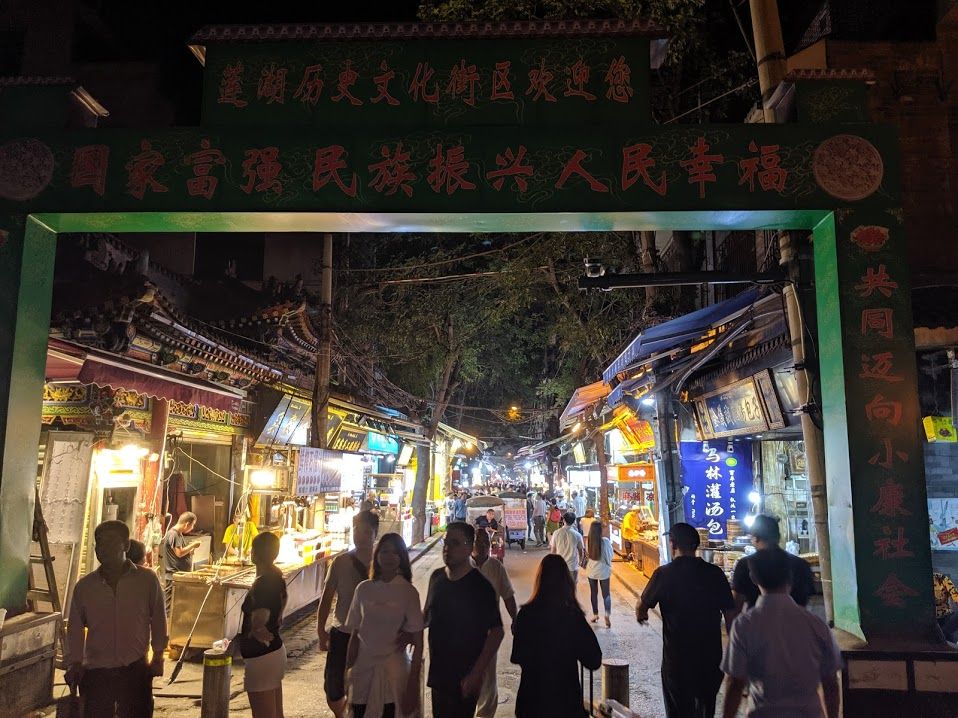
markets, the night market in Xi’an was different than any I had gone to before. You could tell right away the influence the Silk Road had on the city of Xi’an because the second you walked into the night market you could smell a plethora of different middle eastern spices. Not only that, the night market is located around an old mosque that was built for the first Muslim settlers in Xi’an so you can see Islamic architecture and writing on the buildings and walls surrounding the night market. Erwann, Manon, and Olga were fascinated by some of the exotic foods that were being sold at the various stands. There were deep fried crabs on a stick, pigs feet (these were sold by non-Islamic stands) on a stick, grilled squid on a stick, and much much more. We went through the night just soaking it all in and regretting that we had eaten so much food at dinner but even though we were full, we decided we had to try something. It being a staple at almost every night market across China, I bought some candied strawberries and candied shan-zha (a Chinese fruit, almost like a mini apple) for the group to share.
The next day was the competition. The format for the competition was direct elimination from a table of eight with each “world team” fencer matched against a Chinese national team fencer. My first match was against Wu Bin, the current anchor for the Chinese team. Though I have fenced him before and had success, I knew I had to be focused because I hadn’t trained too much yet after World Championships and also the Chinese fencers would have the benefit of the hometown crowd. The preliminary bouts all took place in a mall across from the main gates of the old city of Xi’an. Although it was just the prelims, there was quite a decent crowd spectating the matches so I knew I needed to fence hard. Starting off the bout, I could tell that my opponent was ready and motivated to fence. It was a back and forth affair, trading touches throughout the bout, but I was able to secure my spot in the semi finals, 15-13. My next match was against another Chinese fencer who had beaten Le Pechoux the bout before. Huang Meng Kai is a strong fencer and I’ve actually known him since my last junior world championships. Again, right from the beginning of the match, he was motivated and fencing hard. With the crowd cheering for him, the last Chinese fencer standing, he was able to take me down 15-14 to face Foconi in the finals. Though I lost the bout, I was really honored to partake in the individual event and have so many fans show up to watch the competition. I even won over some new fans when the organizer (knowing I speak Mandarin) asked me to say a few words to the crowd. Even though I had such a good experience during the prelims, nothing would prepare me for what I was going to experience in the finals.
Before the finals began we were taken to the front gates of the old city of Xi’an. These city walls were originally built in the 14th century to protect the old city and the end of the Silk Road. Though we had seen the city walls during the daytime, seeing them lit up during sunset and the night time was quite spectacular. The opening ceremonies began with a presentation and
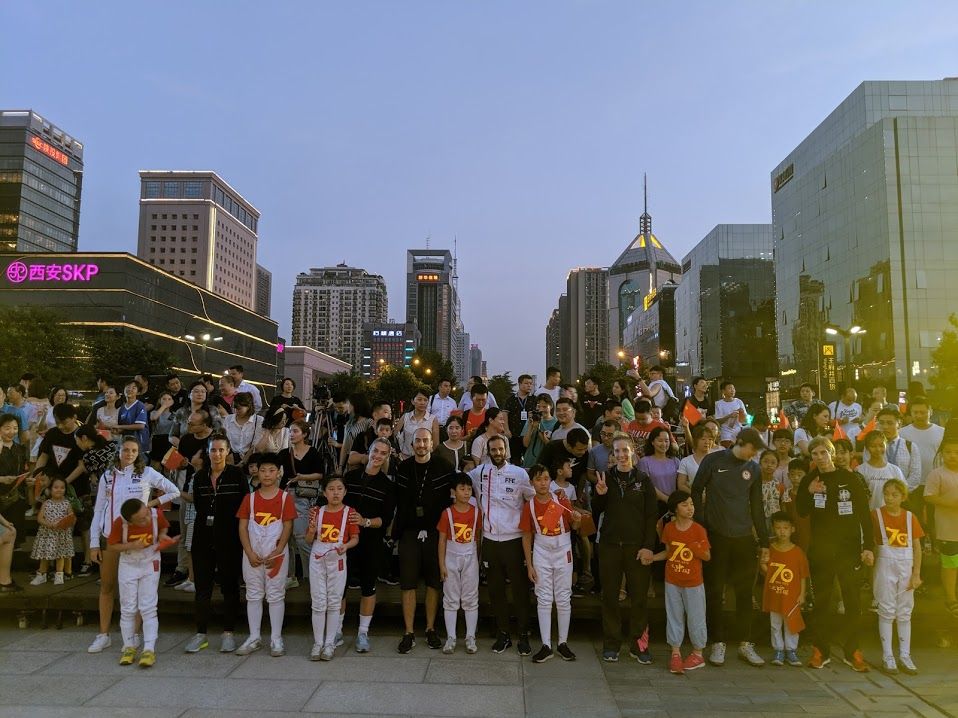
performance of some old Chinese folk songs, all while we were busy signing autographs for the many children in the audience. Though we thought that had the opening ceremonies concluded right there it would’ve already been a great opening ceremonies, we were all blown out of the water with what came next. Once the singing finished and the sun began to set, we began to hear music blaring from the speakers all around the front of the city gates and a light show began right in front of us. The opening ceremony involved over a hundred performers dressed in traditional Chinese garb, not only putting on a performance, but leading us into through the old city walls and to the finals arena. They even brought the drawbridge down for us to ceremonially walk across and into the old city of Xi’an. All the fencers already were in awe of the opening ceremony, but when we came to the finals arena, everyone’s jaws dropped.
The finals were held outdoors, in between two palaces, with a massive jumbotron behind the fencing strip. Even with the wealth of experience shared between Joppich, Le Pechoux, Foconi, and myself, all of us agreed that we had never fenced in a venue like this ever before. Just knowing you are going to fence in a venue like this makes you want to perform as well as possible, no matter the circumstances. Although I didn’t have a chance to finish my individual
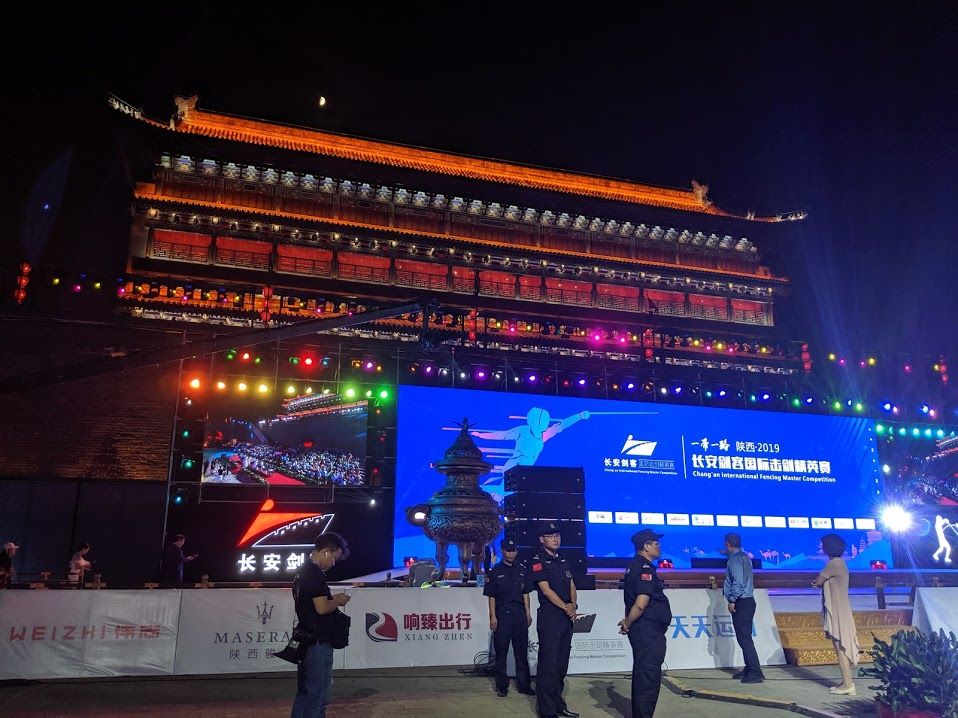
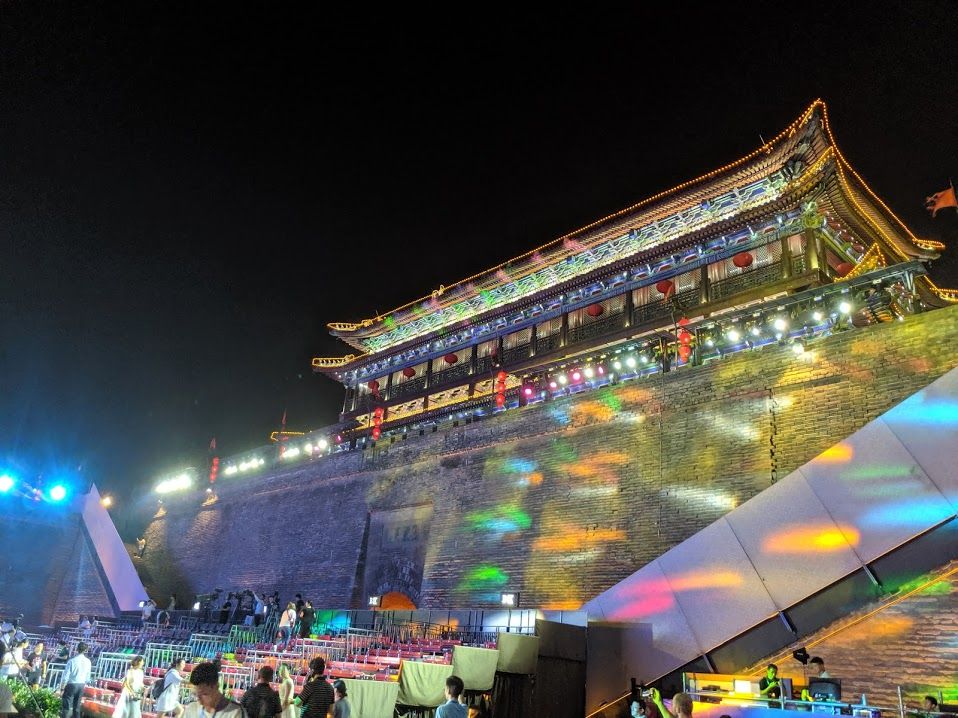
competition in the finals venue, we had the friendly “China vs. the World” team event to come. Unlike the normal team event that involves three fencers fencing the other three fencers on the opposing team to a total score of 45, because this was just a friendly match, each fencer was only to fence one bout against a single fencer on the opposing team. As members of the “World Team” we drew straws to determine the order in which we would fence. The final order, from first to last was: Joppich, Foconi, me, Le Pechoux. Getting on the strip in such a grand fencing venue was truly surreal, but luckily my team gave me a bit of a lead going into my bout. It was really an honor to fence in such a spectacular venue, and I tried to savor the brief moment I was on stage competing up there. I was able to win my bout against Chen Hai Wei and Le Pechoux closed out his bout to bring home the victory for the World Team.
The next day was organized for just sightseeing and relaxation. We started our morning by touring one of the local elementary schools in Xi’an. We were all greeted extremely warmly and it was a good opportunity for us to interact directly with the students and fencers who were
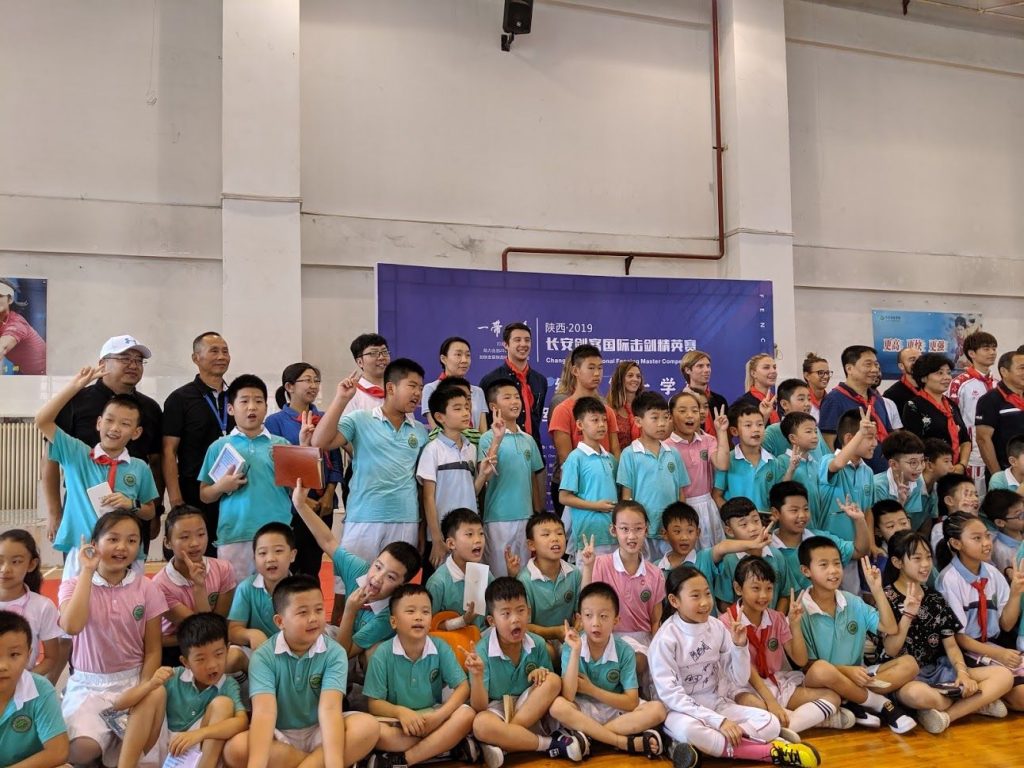
watching the competition the day before. Not only did we get to watch some fencing between the athletes of the school, we were able to spend our time signing autographs and speaking directly with the kids. Being able to interact with the kids on a personal level, and not just taking photos and signing autographs, is what is truly rewarding to me because I want to be able to inspire the next generation and be a role model for the athletes that come after me. Being able to do it in China, where the kids are less exposed to international fencers, is also particularly rewarding because you can tell how excited the kids are to meet, not only me, but all of the athletes who were there.
After we left the school, we finally were headed to where I was most excited to see this trip: the Terracotta Warriors. As I mentioned before, the Terracotta Warriors are extremely culturally significant to the Chinese people and even my mom has always wanted to go see them herself. When she heard I was invited to compete in a competition in Xi’an she told me I had to
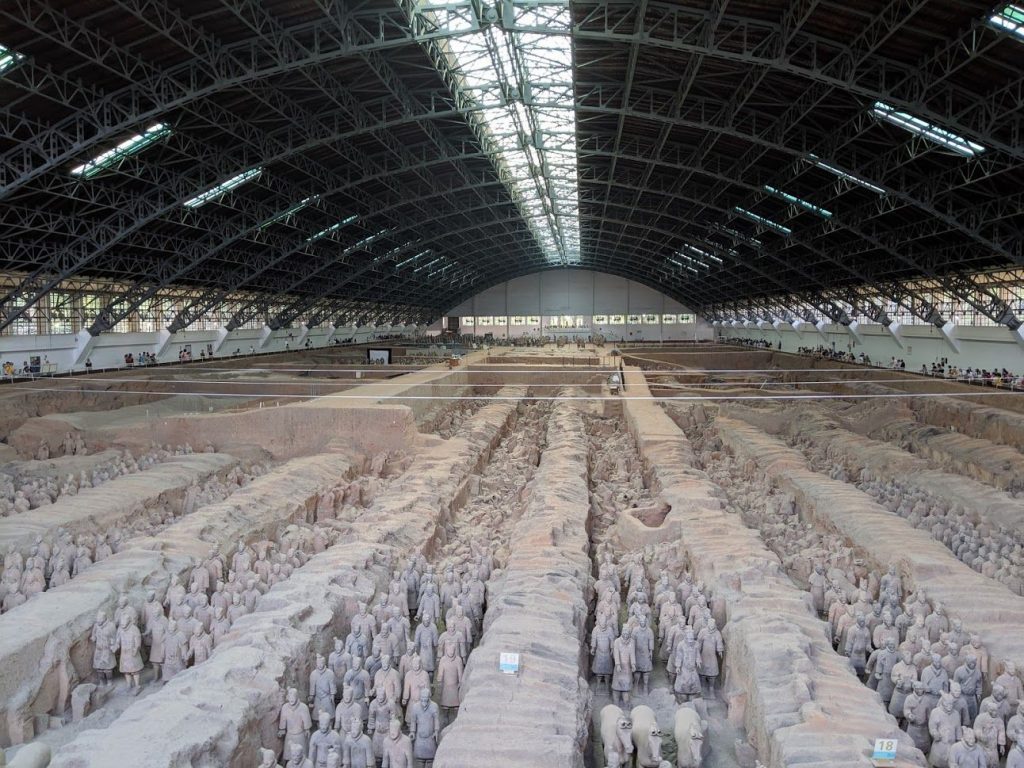
do it, if only to see the Terracotta Warriors. They did not disappoint. The sheer number of warriors was already an amazing sight but, if you look closely, you can notice that the details on each of the several thousands of warriors are completely unique. Whether it be the facial hair carved on the head, the weapons they were carrying, or the colors that they were painted, no two soldiers are the same. Unfortunately the color has faded from most of the soldiers that are open to the public, but there are photos from when the excavation first started that shows how differently each warrior was painted. Not only that, but each warrior carries a different rank based on their height, hairstyle, and uniform. Whether they were a soldier, archer, general, crossbowman, or cavalryman, you can identify their rank or position just by looking at them. All of us were truly blown away by the craftsmanship demonstrated in these ancient warriors, especially because without this trip, many of us would have never seen the Terracotta Warriors in person. Seeing such an integral part of China’s history was absolutely amazing and it was an experience I will never forget.
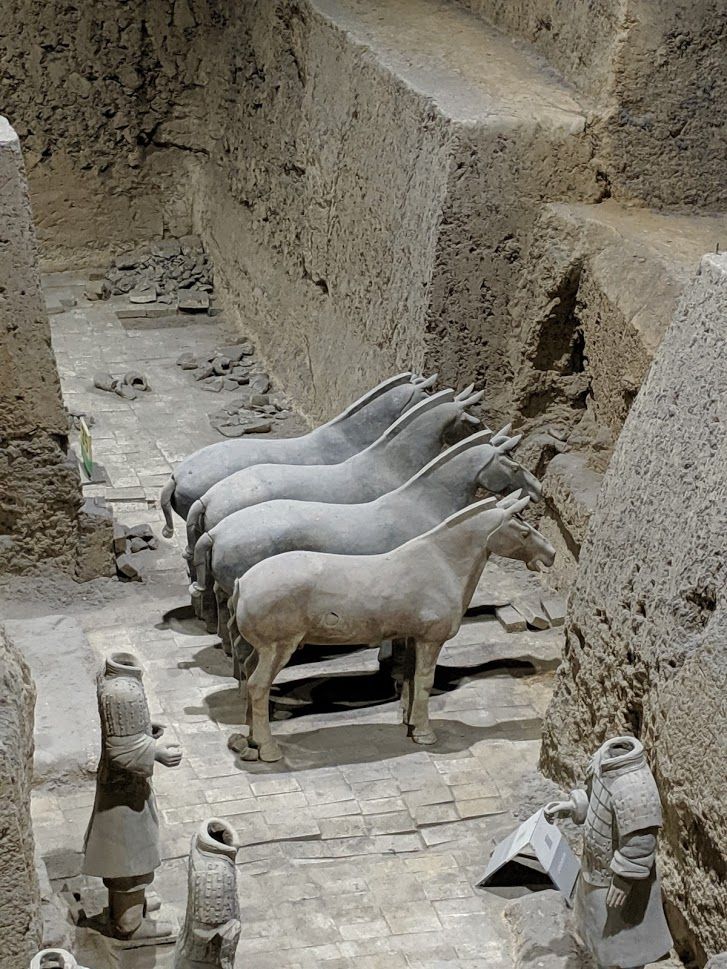
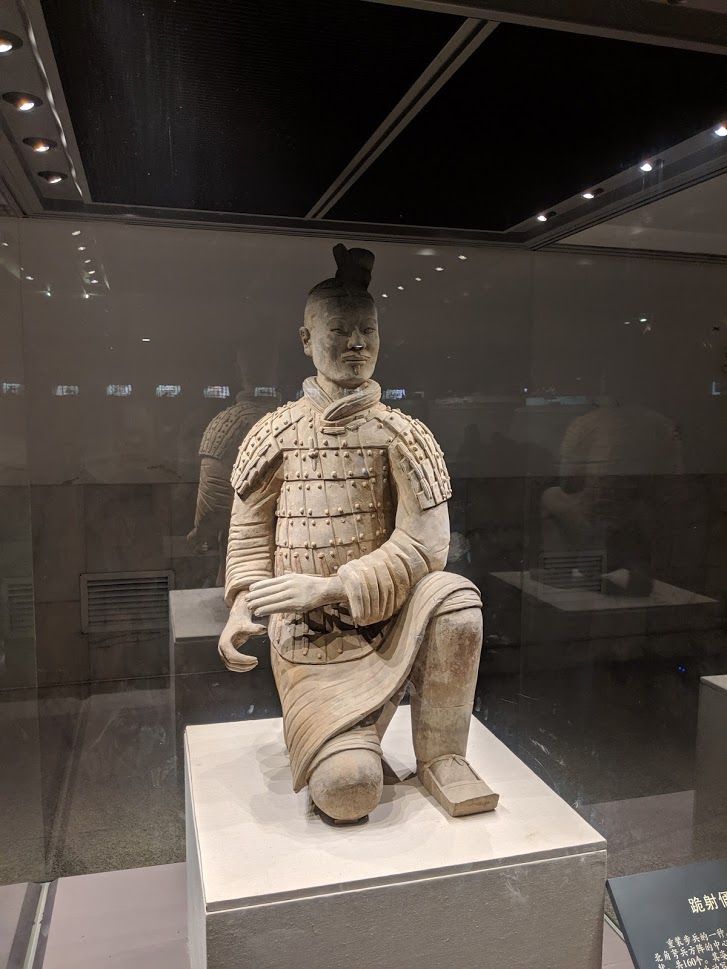
Once we finished our tour of the Terracotta Warriors, our last dinner was to be held at the Xi’an Fencing and Golf Club where some of the fencing official would help host a traditional Chinese dinner. Exhausted from such an exciting day (and trip), it was the perfect way to spend the last night of the trip. These are some of the moments that I will always look back fondly on once I retire from fencing. Outside of the athletic world, how often do people have an opportunity to sit down with friends and competitors from all over the world, just to share a meal and some laughs? A big part of fencing is just enjoying the process. Make new friends from all different places and backgrounds, experience what the world has to offer, be adventurous and do things you have never done before. As we finished that last dinner and thought about heading home, we all agreed on one thing: we were enjoying the process.

